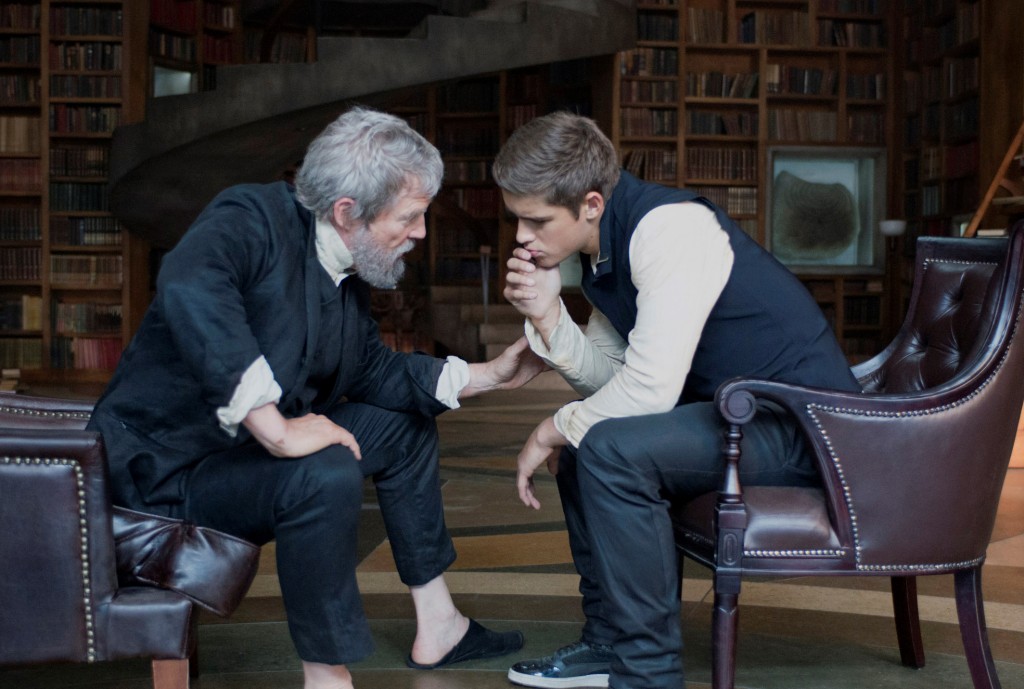by Vi Burgess, staff reporter
A flash of red in an apple thrown into the air. A gleam of green on a tree. The stark black-and-white beginning of “The Giver,” punctuated by occasional colors that escalate in clarity through the film, hints at the coming discovery of something essential, something intangible, something pure: emotion.
“The Giver” centers around the coming-of-age of a boy named Jonas (Brenton Thwaites), who is selected in an unusual event to become the Receiver of Memories in a totalitarian society devoid of true emotion. His mentor, the titular Giver (Jeff Bridges), teaches him the meaning of life, death, and love through the transmission of memories, changing Jonas’s relationship with his friends Asher and Fiona (Cameron Monaghan, Odeya Rush), and his parents (Katie Holmes, Alexander Skarsgård), but most of all, with a struggling newborn, Gabriel.
As a book, “The Giver” has long stood with “1984” as a representation of the effects of a faceless totalitarian society. However, the unnecessary addition of Meryl Streep as the chief villain in the movie, while adding more clarity to the symbolism, manages to cheapen the effect by turning Jonas into a hero and savior for all, when in the book he escaped because he couldn’t cope with society any longer. In addition, the inclusion of a love triangle between Jonas, Fiona, and Asher adds nothing to the plot except the requisite scene of Jonas begging Fiona to run away with him, and her perfectly-scripted, bland refusal, as well as turning Asher into a villain — which contradicts his fun-loving, rule-breaking personality.
In addition, the only character fully developed is the Giver himself, because the audience can see the reasoning and emotions behind his actions, especially when the movie shows his sad memories of Rosemary (Taylor Swift), his former trainee and daughter. The rest of the characters are treated with simple montages showing happiness or anger or sadness, leaving the audience to wonder if most of the characters acted on petty, fleeting emotions. Even Fiona’s newly discovered love seems one-dimensional in comparison to reality, with a grand total of about five minutes of screen time (though I’ll grant that “Up” did the best love story I’ve seen in eight minutes).
However, “The Giver” did not pull the let’s-put-just-enough-diversity-so-that-nobody-will-comment routine, common in other franchises marketed at teens. All of the memory scenes, as relayed from the Giver to Jonas, show real-life ethnic, historical, and religious diversity, from Tiananmen Square to a Shabbat. In addition, the cinematography in the memory scenes is extraordinary, with choppy, vivid, blurry two-second flashes that are extremely realistic. Also, the film’s slow transition from black-and-white to color, as written in the book, create a more visual mirroring of Jonas’s new knowledge.
As a film, “The Giver” will most likely forever be classified as “one of those YA films” just as we now have a set of “those 90’s movies.” Its strength in cinematography and diversity is overshadowed by the flaws in the plot and character development, and its seriousness rules out the “cutesy/empowering” factor. If you’re bored of everything else in the theaters, go see it. But if you, like many others, idolized the book as a child, let the story rest in your imagination, not on the big screen.
Photo via The Weinstein Company. Watch the official trailer for “The Giver” here.


